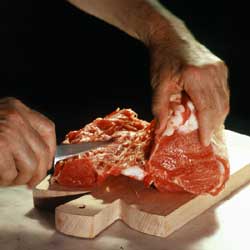| |
|
Alessi cuisine
|
|
| |
Chine of pork "alla Fiorentina"
(Arista alla fiorentina)
|
- 2 kilograms of chine of pork with its bone
- 8 garlic cloves
- 10-12 leaves of sage
- the leaves of two small branches of rosemary
- one pinch of fennel seeds
- one big pinch of black pepper
- one pinch of spices
- salt and pepper
- olive oil
- vegetable oil
- 1 glass of white wine
- 2 small glasses of grappa
|
 Take
a blender and put as much oil as to cover the blades in order it can mix
properly, then add garlics, sage, rosemary, fennel, pepper, spices and salt.
Mix all these ingredients very well as to have a quite thick and homogeneous
mixture. Then take the chine of pork, salt and pepper it a little bit, spread
it abundatly and uniformely with the above described mixture. Take
a blender and put as much oil as to cover the blades in order it can mix
properly, then add garlics, sage, rosemary, fennel, pepper, spices and salt.
Mix all these ingredients very well as to have a quite thick and homogeneous
mixture. Then take the chine of pork, salt and pepper it a little bit, spread
it abundatly and uniformely with the above described mixture.
Take a sheet of tinfoil and wrap the chine of pork very tightly; put it
in the refrigerator for a night as it can acquire flavour. At the right
time take a baking-pan, grease it with abundant vegetable oil, position
the chine of pork wrapped in the tinfoil, sprinkle it with the same oil,
put in the oven for 40 minutes, at the temperature of 200° C, turning
the wrapped chine of pork several times. At the right time, open the tinfoil
(and then drop it) in order to let the meat get browned, bathe with white
wine, turn the meat as soon as the wine will be evaporated, after 10-12
minutes, and then sprinkle it with grappa. Some 4-5 minutes more of cooking,
then take out from the oven and cut the chine of bork into small steaks,
which will be served over a layer of turnip leaves, boiled and sauted in
a frying pan together with the cooking bottom of the pork. |
|
|
|
|
| |
|
|
|
| |
|
|
|
|